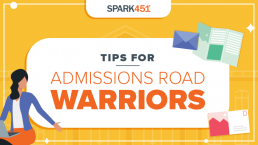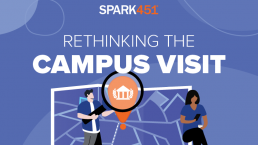The Return of College Fairs is Gearing Up to be Big: It’s Finally Time to Rethink Your Travel Materials
I attended my first college fair this month.
Correction, I attended my first college fair as a parent of a high school sophomore just starting the college search. For roughly 15 years, I’ve assisted partner colleges and universities in their recruitment efforts through marketing campaigns and other creative projects. But now, I have the opportunity to experience this kind of event through a new lens.
Joining my daughter in the cafeteria at Marjory Stoneman Douglas High School, which had been converted into a coliseum for collegiate competition, was like field research for me. I am happy to share a few key takeaways with you.
Grab attention and invite them to approach
Looking around the fair, my daughter recognized the brand names — even a few we work with — and I spotted some schools I’ve never heard of. Yet, among all, there were few things that stood out to us first:
- Is the school’s logo even readable? Is it optimally sized to the tablecloth or runner, or is it hidden by folds? Don’t make attendees struggle to read the name of your school or they’re likely to walk past it.
- Is the brand prominently and consistently displayed with the school’s primary colors matching across all materials? Nothing says “sloppy lack of quality” like showing off your signature blue or maroon in 10 different shades or using multiple versions of the logo across all materials. While the collateral on your table may be produced at different times, on different materials, and by different processes, consistency is key to project high quality.
- Is the table attractive, tidy, and well organized? Give guests a reason to approach by flaunting your best giveaways and informative pubs.
- Is there information easily visible to those just passing by? Consider using lightweight pull ups and table tents, as well as available tech to show off interactive content like teaser videos or campus tours. Don’t forget that showing off your school pride extends to attire, too. Consider a lapel pin, tie, or even branded shirt to complete the impression.
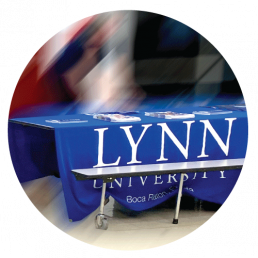
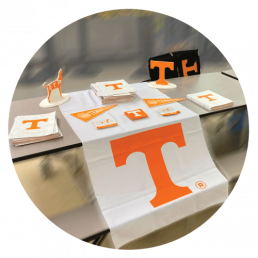
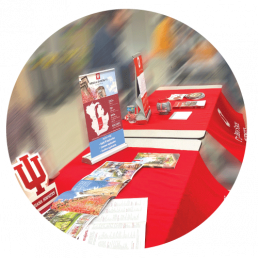
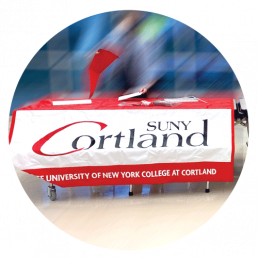
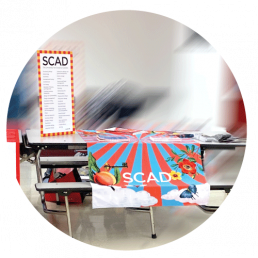

Give them a reason to invest a few precious minutes that may lead to a return on investment for years to come
The faces of some high schoolers — usually those escorted by the most enthusiastic parents — showed reluctance, or uncertainty. Even when they did approach a booth, they often weren’t sure how to begin or what they were supposed to ask. What can you do to ease the initial engagement?
- Why not feed them an opening line? Consider a sign that offers a scripted opening around your point of pride: “Ask me how [your institutions] can help make your education affordable.”
- Boldly display key stats and information on pullups or table materials to give your guests general information. This will enable you to spend your time on deeper discussion.
- Have abundant swag laid out for the taking; who doesn’t love a freebie? Offering a fun branded giveaway (when permitted) is a no-pressure way of starting up a conversation.
- Integrate interactive elements through A/R or simply use QR codes. I know we’re all still in disbelief that the square graphics made a comeback like they did. Looking around the hall, I was hard pressed to find a student without a phone in their hand. Give them something to scan quickly. You can drive digital engagement by offering an A/R experience of a campus facilities tour or by scanning a QR code for a quick visit to a landing page’s inquiry form for additional information.
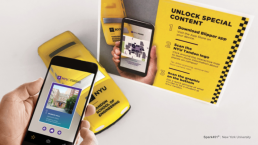
Offer them “one for the road”
You’d be surprised how effective tangible takeaways can be — even for digital natives. Giving your guests something to take with them is an important way of continuing the conversation at home, after they’ve had time to process and compare everything they learned at the college fair.
- Unique formats, special print treatments, and unusual materials and textures make your materials desirable at first glance.
- Of course, what’s inside is even more important. As families are beginning to compile their list of potential schools, make sure your travel publications contain vital information about areas of study, location, outcomes, cost and aid, average scores and GPA requirements, and visit information. Don’t forget to include a vanity URL to drive (and track) engagement.
- Do you have differentiated materials on the ready? A single travel piece may not cut it anymore. Do you have brochures, single sheets, or even postcards to introduce your newest programs? Consider which areas of study are struggling and prepare marketing materials to support them. Make sure you have pieces covering financial aid and outcomes, especially important for parents/guardians. And let’s not forget campus life pubs promoting the benefits of living on campus to keep your residence halls filled. Before you get dizzy at the thought of hiring a moving truck to transport everything, remember, you don’t have to lug dozens of every type of piece with you. With a couple of samples on display, you can offer an all-encompassing digital guide with downloads or to mail them physical copies in exchange for their contact information.
- Whether you still use inquiry cards or offer a digital form, make sure they sign up to receive all other information in the form of your nurture stream.
So, what do you really need for your recruitment travel?
By now, you realize that basic promotional items such as a tablecloth, an inquiry card, and a single brochure are not enough. I have shared a few ways to stand out in the minds of your guests (and avoid “travel envy” from your own road warriors), but there are countless other tactics that are appropriate for different schools. Make sure that when it comes time to present your institution’s offerings, nobody has cooler swag or more engaging publications and interactive table displays to attract foot traffic at busy college fairs.
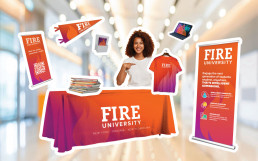
Why it’s crucial to plan now for next season
Today’s college-bound students have faced a difficult few years, so many are eager to finally embrace the excitement and freedom of what college life has to offer and are hoping to find the right fit school. Recent trends show that students are applying to more and more colleges, so there’s greater pressure on you to do everything you can to set your institution apart from the competition and forge a genuine connection. There are few better opportunities to do that than on the road at college fairs and other recruiting events, and that end-of-summer rush will be here before you know it!
Get it done professionally
Now is the time to make sure your road warriors have everything they need to help recruit your best class yet. The admissions and creative professionals at Spark451 are eager to help you do just that. We’ll work with you to produce inspiring, professional materials that will make it easier to engage prospective students and drive conversions. We’ll even handle production and project management from conception through delivery, so your busy team doesn’t have to!
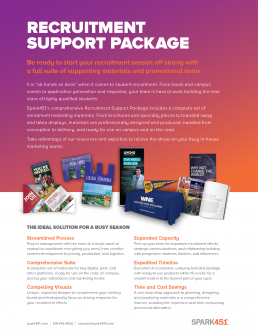
What’s even better is that we have a comprehensive Recruitment Support Package, which features a full suite of enrollment marketing materials — including a collection of travel pieces, recruitment table displays, branded swag, and more to fit a budget of any size. When you’re ready, reach out so we can help you determine which products best suit your means and enrollment goals.
Rethinking and Tracking the Campus Visit
We all clearly understand that the impacts of the COVID-19 pandemic have changed the ability of students and their families to visit campus while, at the same time, the rapid shift to virtual events has also expanded what constitutes a visit in general. So, what has really changed when it comes to campus visits and their impact on your enrollment funnel, and how should you be adapting your approach to planning, marketing, and tracking events in the new normal of 2022? Let’s explore, shall we?
To begin, here are just a few key findings from Spark451’s most recent College-Bound Student Survey:
- Survey respondents ranked “location setting” (#3) and “campus appearance” (#6) among the top 10 factors they considered when making their college decisions
- 21% of students said they knew their school was right for them when they first visited
- 57% of students said they visited campus before making a deposit
But here is where the COVID-inspired, Zoom-driven realities of our time have shown their impact:
- 64% of respondents said their college decision was influenced by attending a campus event, such as an Open House or Admitted Students Day, down from 74% four years ago.
- And over 50% said that those impactful “visits” were virtual events!
Campus Visits—Still The Ultimate KPI
It’s a nearly universal truth of higher ed admission. Students who visit campus generally move through the admissions funnel at a significantly higher rate than those who don’t visit. Not only that, the later in the admissions process that they visit, and the more times they visit, the higher the likelihood that they will enroll. So it stands to reason that schools should place a premium on finding ways to get students and their families to visit.
While most schools are acutely aware of the negative impact they’ve felt by the recent decreases they’ve seen in campus visitors, too few actually factor campus visit numbers into their Key Performance Indicators (KPIs) for their enrollment funnels and projections. Most institutions keep track of the total number of campus visitors from year to year as a general indicator of interest in their prospect pools. This approach provides a broad sense of overall interest in your institution, but it falls short of providing a true projection of potential enrollment. Tracking campus visit totals alongside your admissions funnel data at each stage—prospects, applicants, admits, and deposits—will give you a truer sense of the level of interest and engagement, and the overall strength within each segment. In an ideal world, your visit percentages should increase at each stage of the funnel. At the very least, you should aim for consistency throughout.
To gain an even more robust level of analysis of your visit pool, you may want to consider utilizing an analytical service like Spark451’s proprietary Enrollytics service to consolidate your engagement metrics, including campus visits, along with demographic, academic, and socio-economic factors to turn data tracking into enrollment predictability. By reviewing your historical enrollment and visit data, we can help you determine just how impactful your campus visit experiences are on your admissions funnel productivity, as well as next-level data like who is visiting and who is not. By drawing true correlations between campus visits and a student’s progress to the next stage of your admissions funnel, you will be empowered to either continue your already effective visit processes or enhance them as needed. Additionally, you will gain a data-driven perspective on the likelihood that your applicants and admits will eventually matriculate.
Get the Most Out of Every Visit Opportunity
So, it’s clear that enrollment planning must still involve maximizing campus visitors. However, we must also now adjust our mindset to what our audience considers to be a campus visit these days. The realities of the pandemic era have fundamentally altered the ability, if not the desire, of many families to make long-distance trips to visit multiple campuses in person for a variety of reasons, ranging from health concerns to finances. Additionally, the rise of virtual information tours and info sessions, and even full scale events like virtual open houses immediately made necessary in 2020, have enabled families to broaden their definition of a campus visit, and in turn, “visit” more schools than ever before.
This is not to imply that the virtual visit experience is a good replacement for an in-person visit. Indeed, there’s no replacing the feeling of finding one’s home away from home that a student can get when they set foot on the “right fit” campus. It’s priceless.
But the fact is that fewer families are visiting in person, and colleges and universities can’t let that be a hindrance to the overall enrollment boost that campus visitors provide. The answer is to provide as many and as varied an assortment of on-campus visit opportunities as possible, but to also expand your reach by providing virtual options for those who need them.
Here are several strategies for planning both on-campus and virtual visits that drive enrollment results:
1. You don’t have to do more to do better
Adding a consistent virtual component to your campus visit repertoire doesn’t have to mean doubling the workload of your team by doing twice as many events. By setting aside specific times during your campus events where families can join in online for an information session or meet with a counselor, you can increase your reach without adding to your calendar.
Additionally, working with your IT and audio-visual teams on campus to plan for well-orchestrated recordings of your campus events can enable you to post a visit experience online for families to view whenever and wherever they are available.
Spark451 has a wealth of resources and solutions to help you make the most of your virtual visit offerings.
2. Invite students early and often
Communication to students at every stage of your admissions funnel should involve calls to action to visit campus. Don’t wait for the student to request a visit—make it clear that they’re always welcome, and give them a good reason to make the effort!
3. Provide programming tailored to each specific funnel stage
One-size-fits-all campus events are too vague and impersonal. Generation Z students prefer more intimate, even personalized visit experiences. A high school junior and an admitted senior need very different information and experiences in order to feel like their visits were helpful. Be sure to have designated events for underclassmen, senior prospects, applicants, and admitted students — each geared toward helping attendees take the next step in the funnel process.
4. Reach unengaged populations with additional, public-service events
In addition to the standard admissions-centered campus events and visit experiences, it’s worthwhile to provide generally informative, community-oriented, and/or service-related visit opportunities as a means to maximize foot traffic on your campus. Some simple examples of public service or general info events are Financial Aid Nights, events where the public can gain free tax-prep assistance from students in your business department, or program-specific field trips for high school classes. These “non-admissions” events can serve as incredibly compelling “sales pitches” to otherwise unengaged populations, which can allow you to expand your long-term funnel.
5. Take a multichannel approach to publicizing events
Communicating visit opportunities across multiple mediums will help ensure your message lands. Mailed invitations are always impactful for parents, while emails and texts make it easy for students to RSVP with the click of a button. This is where a robust CRM platform is invaluable. It empowers you to centralize and segment your communication efforts for hyper-targeted and efficient messaging, to simplify the visit registration process, and even keep consistent records of all campus visitors. If you’re one of the many campuses that has a CRM like Slate, Salesforce, or Element451 in place, but doesn’t have the personnel or bandwidth to use it to its fullest potential, the team at Spark451 provides our SparkAssist partnership program to provide the backend support you need.
6. Incentivize campus visits
High school students are applying to more schools than ever these days. Our research indicates that 40% of students today apply to eight or more schools. This ever-increasing “short list” means that visiting every school is less and less feasible. Therefore, you must provide compelling reasons for a student to prioritize visiting your campus. Incentives can range from the basic visit scholarship or travel voucher to tying your admissions programming to exciting events on campus or in the local area. This serves the purpose of encouraging campus visits while also telling the story of what there is to do outside of class.
We Can Help
As a full-service marketing communication and technology firm made up of seasoned admissions leaders and an award-winning in-house creative team, Spark451 is uniquely positioned to partner with colleges and universities to utilize best practices along with bold new ideas to boost your campus visit programs and positively impact your enrollment funnel at every stage. We’d love to speak with you about your school’s current campus visit and event challenges and help strategize some unique solutions. Reach out and connect today!
